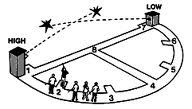
The skeet field is laid out on a semi-circle (or half "clock") with eight stations for shooting. Seven stations are positioned at equal distances on the perimeter of the "clock" with the eighth in the middle on a line between position one and seven. (Station one would be the numeral twelve on a clock; position seven would be the numeral six.) High targets are thrown from station one at one end of the semi-circle; low targets from station seven at the other end. The trap houses at station one and seven are called the "high house" and "low house." Targets are always thrown in the same pattern of flight, but the angle of the shot varies because the shooter changes position as the skeet squad moves from station to station. Two targets are shot from each of the eight stations. One from each house, and doubles, where targets are thrown simultaneously from both houses, are shot at stations 1, 2, 6, and 7. The twenty-fifth shot is called the "option shot" and is a carry-over from the days when the shooter had a choice of his 25th shot if he hit the first 24. The shooter no longer has any choice of where to take the "option shot."
Before getting into the specifics of shooting trap and skeet, let's look at some basics which are common to shooting any clay target. If you can see the target with either normal eyesight or corrected vision and have average coordination, you can learn to hit a moving target with a shotgun-and will hit the target. The important things to learn in shooting at moving targets are: proper stance, correct gun mounting, the right sight alignment, the need to lead the target, and the importance of swing and follow-through.
Each of these steps will be dealt with in detail in the advanced and competition courses. For the beginning course, we will concentrate on simply getting used to seeing the targets in the prescribed flight, tracking the targets, swing and follow-through. The leads recommended by the instructors for each target in skeet are given below. One must remember that the apparent lead for each shooter may be different from these suggested leads. This is due to each person's unique swing and sight picture. If the suggested lead does not work for you, be prepared to modify according to what you and the instructor think best. The recommended leads are:
Station One: High House-0 lead Low House-1 foot Station Two: High House-0 lead Low House-1 to 1 1/2 feet Station Three: High House-3 to 4 1/2 feet Low House-3 to 4 1/2 feet Station Four: High House-3 to 4 1/2 feet Low House-3 to 4 1/2 feet Station Six: High House-1 foot Low House-0 lead Station Seven: High House-4 to 8 inches Low House-0 lead Station Eight: High House-0 lead, fast swing, catch the target and shoot Low House-0 lead, fast swing, catch the target and shoot
Again, these leads have been developed through our years of teaching. These will not work for every shooter, but you have to begin somewhere. The instructor will be able to adjust each shooter as he is shooting the targets.